
|   |

|   |
 e-mail: sunilkothari1933@gmail.com 13th edition of The Music Academy Dance Festival-Part 2 Photos courtesy: The Music Academy January 30, 2019 13th edition of The Music Academy Dance Festival - Part 1 Day four On 6th January, I missed the recital by young Harinie Jeevitha, disciple of Sheela Unnikrishnan whose disciples I have seen in group work and I have enjoyed her excellent training and uniform performances by her disciples. I was keen to watch Bharatanatyam by Parshwanath Upadhye who has been making waves. I missed the evening performances by Mythili Prakash in Bharatanatyam and Sujata Mohapatra's Odissi. It was my loss. Day five Bhavajan Kumar 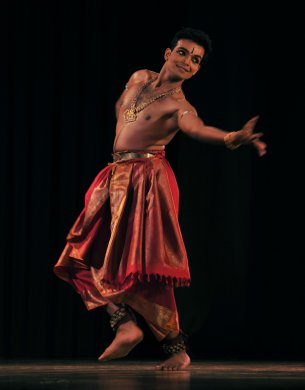 I reached the auditorium when Bhavajan Kumar currently studying under Leela Samson, had just completed his recital, but could catch up with The Dhananjayans' disciple Divya Devaguptapu. Divya Devaguptapu 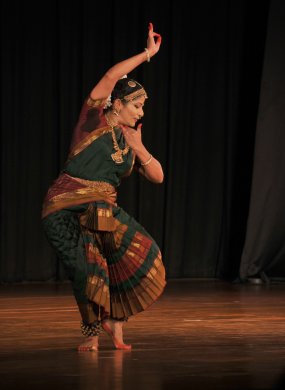 Alarippu titled as Sannidhi in Ragamalika and misra chapu tala with jathi composition by K.P Ramesh Babu, was in nature of prayer to Ashta Dikpalas as she moved in eight directions. It wore a new look that she created through movements entering the temple, sculpting the statues, offering worship and spreading the flowers. One saw in her rendition of Tiger Varadachari's varnam (Dhananjayan prefers to call it Nrityopaharam) Ehi Manmadha koti in Sriranjani raga and adi tala, arrangements of nritta in triangle. The nayak being none other than Krishna, Divya described Krishna's melodious music on flute, his neck like a conch, eyes beautiful like a doe, lovely hair, offering worship to such a handsome lord more handsome than millions of Kamadeva, koti sundar, embellishing it with scintillating nritta and perfect teermanams. Dance for Divya seemed to be a theatre of imagination as she created Brindavan, cows, and birds enticed listening to Krishna's flute, the creepers and flowers also swaying to the notes of the flute. The peacocks danced, gopis under Krishna's spell, desirous of embrace, dancing holding arms of other gopis and clapping. She unleashed images of Kalinga nartana, lifting Govardhana mountain, killing demon Bakasura, and taking Vishwarupa. Addressing Krishna in later part of varnam as Madhava, Venudhara, beseeching his love, describing him as Rajivalochana, lotus eyed, she rendered complex structure of varnam investing it with several images of nayika drawing his painting, studding it with pearls, awaiting his arrival wearing new clothes, decorating the place with garlands and so on. However too many images overloaded the presentation. She would do well with restrain and less images. In Viruttam Guha Sampramoha Divya took interesting concept of the ten year old Muruga watching with dismay, the fused form of Lord Shiva and mother Parvati creating confusion, whereas Ganesha invested with intelligence, looks at it philosophically as union of two. The Tillana was not presented due to lack of time. Divya was accompanied by Aadith Narayan on nattuvangam, mridangam by K.P. Ramesh Babu, vocal by Ranjani Ramakrishnan, kanjira by Sunil Kumar and violin by Rijesh Goplakrishnan. She acknowledged as resource persons Dr. Kanakam Devaguptapu and Dr. Nagabhushan Sindhushayana. Lighting was by B. Charles and Murugan Krishnan. Malavika Sarukkai 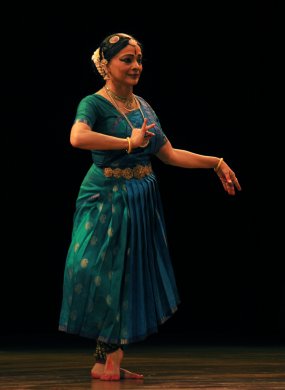 In the evening, senior dancer Malavika Sarukkai presented Gangavataran in Ragamalika and talamalika to the music composed by M.S. Sukhi. She referred to Lord Shiva receiving Ganga in his matted locks. Turning her back to the audience Malavika with raised arms created the height of the insurmountable Himalayas. She presented with great energy the rivers Bhagirathi and Alaknanda flowing on to the plains of India. The devotees at their sangam watching the sight sang and praised the holy meeting of the two rivers. The refrain of 'Jatadharaya, Har Har Shambho' created the ambience of the crowds at sangam. The use of mridangam to enhance the flowing waters, and singing Bhagavati Gange, Tribhuvanadharini Gange resounded from the banks of the rivers. Malavika dwelt upon how water fell drop by drop, and turned into a gushing flow using sollus ta dhin dhin dhin ta, with strong sound texture. Nritta was embellished by solfa swaras. The towering pinnacles of Himalaya mountain range, the use of Hindustani music, all were used to create the magic - the epithets Sukhadayini, the whirlpools generated, bathing, the song 'Tum rasa range', offering knowledge, the lamps placed in her waters, the rituals performed by devotees on the banks, the icon of Bhagirathi took shape before one's eyes. In another composition titled Varsha, inspired from Shrimad Bhagavata and also the 17th century miniature paintings, Malavika used the music specially composed by late Seetharama Sharma using Pahadi raga and by C.V. Chandrasekhar using Ragamalika. The lifting of mount Govardhana when Indra sent rains for seven nights, the cows, the birds, the gopa balakas, the gopis, all looked up to the lord for protection. Earlier the drops, then gopis lifting their sarees and carefully crossing the puddles, looking up at the sky, Indra astride his elephant, angry and furious, the crowds aghast,' 'Hahakara' resounding all over and Krishna lifting up Govardhana on his little finger, holding flute in another hand, protected all. The thunder storm, the chaos that frightened the people was created with appropriate movements which had strong resemblance to paintings. The gopa balakas look in all directions. They dance in joy, like what is mentioned in Srimad Bhagavata, the Hallisaka nartana, clapping and moving in circle. The blooming lotuses in Yamuna, with refrain of kamalam, hastam kamalam, valanam kamalam, nayanam kamalam, vadanam kamalam, set in raga Amritavarshini, created the musical landscape. Malavika's own study of Pichvai paintings found expression in this sequence. Malavika suggested ripples of meaning that are explored in the verses of Andal, Nammalvar and Sant Namdev, connecting the three. In the Andal piece, Malavika showed some young gopis making sand castles and bewitched by Krishna, they beg of him not to break their sand castles. It is the season of torrential rains, describes Nammalvar. The nayika is alone waiting for Krishna. She searches for him in cloud, ocean and in the rain. Then switching off to Sant Namdev, she enacted pilgrims coming in crowds to Pandharpura, for darshan of Vithala and their singing with cymbals, creating an atmosphere of a pilgrimage. The merging of Vithala praised by Namdev with Sheshasayi Padmanabha image was artistic. She maintains that she is following the path of Margam, as her journey of dance through her various creations. She was accompanied by Srilatha on nattuvangam, on vocal by Murali Parthsarathy, mridangam by Nellai Balaji, violin by Easwar Ramakrishnan. The costumes were designed by Sandhya Raman and lights were handled by Venkatesh Krishnan. Aditi Mangaldas 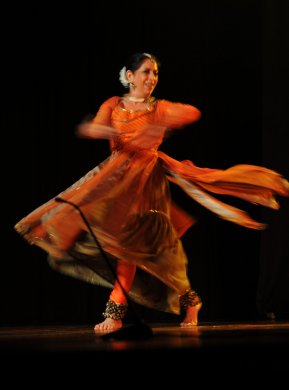 Kathak dancer Aditi Mangaldas presented Widening Circles that premiered during Malavika Sarukkai's Natya Darshan festival three years ago in Chennai. Viewing it a third time revealed more nuances. Using the metaphor of the blossoming lotus in this universe, she connects the metaphor to the widening circles of life. She has with this imagery explored the concept of 'everything is interconnected'. She presented it in three parts: The Sun, The Earth and The Moon, using the nritta aspect of Kathak, the literature shlokas for The Sun from Kathopanishad and Prashnopanishad, for The Earth, Urdu couplet by Ahmed Nadeem Qasimi, and for The Moon, the bandish by Meerabai. The use of recitation of excerpts from French poet Maria Rilke for widening circles: 'I live my life in widening circles...' and of Gurudev Tagore 'On the day when Lotus bloomed…' In The Sun she danced with vigour to suggest the glorious and mighty aspect of the sun. Her taking circles round the stage has become now a signature and the flawless breathtaking chakkars win rounds of applause. The pirouettes are not performed as in a regular Kathak recital, but are a part of the movement of the sun. The rays of the sun connect, touch with delicacy the bud of the lotus which blooms, connects with life. In traditional Kathak, it is customary to allow the accompanying instrumentalists to display their virtuosity on pakhavaj and tabla. Ashish Gangani, the young pakhavaj player, played various bols and showed variations with great flair. Similarly, Mohit Gangani showed his command over tabla with dexterity. Sarangi by Kamal Ahmed invariably stirs the souls, as it is indeed the soul of Kathak. This interlude gave the dancer time to change costume for the next sequence of The Earth. Ah, just as the bud opens at the crack of the dawn, the stars wink and withdraw. The various intra forms of Kathak like tode, tukde, tihai, and parans are dovetailed imaginatively. The earth populated by the animals, the deer, and the fish in the water, the trees and the creepers celebrates life. The recitation of the text by Tagore takes visual form with tremulous fingers of Aditi sitting on the floor and reciting the beautiful poem kept in front of the non-obtrusive mike. Aditi uses a prop of a book and reads from it. The lights dim and then follows the next part of The Moon. Using Meerabai's song 'Main Birahan baithi jagu jagat saba soveri ali' - I am a separated nayika, Birhan, I await my Lord, and the entire universe is asleep, whereas I cannot sleep - the metaphor comes alive as when the Moon rises alas, the blossoming lotus once again as a bud, must endure these parting pangs of separation from the beloved. Aditi performs the tintinnabulations of ankle bells till only one bell rings and then sits on the floor. The prop of the book at this time is all aglow with light. She recites: 'I live my life in widening circles...' Among Kathak dancers Aditi stands out for her explorations using various themes, weaving the technique of Kathak in a seamless manner. As a noted critic has summed up: 'Aditi's dance form Kathak is centuries old, but her sensibility is as modern as today. She has astonishing technical skills; yet her dance is more than that. It is movement as a series of answers to questions posed by her inquiring mind…. Her expression ranges from wonderment to bliss. Her dance demonstrates what it means to be utterly free in body, mind and spirit to explore the world.' I endorse it. Those not used to contemporary approach in Kathak are often left confused. In particular, in the South contemporary Kathak based on traditional classical Kathak is rarely seen. Aditi has made a breakthrough in this aspect. Aditi has a team of musicians with her for a long time. Many felt that her vocalist and musicians' renderings of songs bordered on higher decimal and detracted from pleasant sound. Choreography and costumes designing by Aditi, lighting by Govind Singh Yadav executed by Milind Srivastav, and for resources Aditi acknowledged noted art historian Dr. B.N. Goswami, Devyani Mangaldas, Gita Vasudevan, Radhika Jayakar and Mamata Mangaldas. Day six Sudharma Vaithiyanathan 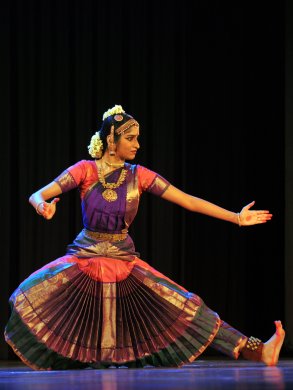 The morning session featured Sudharma Vaithiyanathan and Jyotsna Jagannathan. Sudharma has been studying under A. Lakshmanaswamy for past 13 years, after her arangetram under Srekala Bharath. Her performance comprised of Pushpanjali, varnam Sami Ninne, a padam Yarukagilum bayama, a javali Itu Sahasamulu and Khamas tillana. She is a versatile dancer and did justice to whatever she performed in all departments grammatically. Her rendering of abhinaya in traditional padam Yarukagilum bayama stood out for bold depiction and 'I do not care' attitude, building up the spirit of the upfront nayika. Patnam Subramanyam Iyer's Tillana in Khamas was scintillating. She was accompanied by A.Lakshmanaswamy on nattuvangam, vocal by K. Hariprasad, violin by Easwar Ramakrishnan, flute by K. Shashidar, mridangam by Nellai D. Kannan. Jyotsna Jagannathan 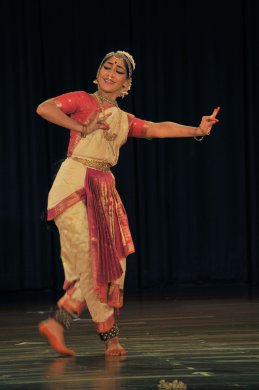 Trained by Jayanthi Subramanian and later on pursuing further with A. Lakshmanaswamy and Bragha Bessell, Jyotsna is now being mentored by Malavika Sarukkai that has paid good dividends and she has progressed well during past three years. Ardhanari Stotram in Ragamalika and adi tala to the music composed by K. Hariprasad was quite impressive in terms of her approach to the Stotram. The two aspects of Shiva and his consort Parvati were depicted appropriately taking into account the epithets of both the divinities. Varnam Mohamana yen meedhil in Bhairavi and rupaka tala was choreographed by Jyotsna. Seeing the lord in a procession astride Nandi, the nayika is bewitched. She prays for the union with the lord who is none else than Thyagesha. The description of the citadel, the high towers, entering the doors of the temple, watching the priests offering worship to the lord, and when dwelling upon the epithet Thyagesha, she elaborated her sentiments, extolling his greatness .In the latter part the flowery arrows of Kamadeva causing agony, the pathetic state when she could not bear the sweet cooing of koel bird, unable to bear the rays of the moon et al were enacted with deep feelings. She displayed her accomplishment in both abhinaya and nritta. In the ashtapadi Dheere sameere Yamuna teere Jyotsna feelingly enacted the role of Sakhi and described the state of Krishna awaiting Radha, anxious to see her, sending message on the flute, touching the sand on which Radha has walked, seeing her holding garland of flowers and embracing her. Balamurali Krishna's Tillana in Behag raga and adi tala is a favourite one with dancers. In composing the tillana the great musician has poured his soul into it keeping in view how dancers can perform. Grasping this well, Jyotsna performed it with inherent joy. She had support of musicians who are much sought after. Nattuvangam by S. Srilatha, vocal by Murali Parthasarathy, mridangam by Ramesh Babu, violin by Easwar Ramakrishnan and flute by Mahesh Swamy. Praveen Kumar 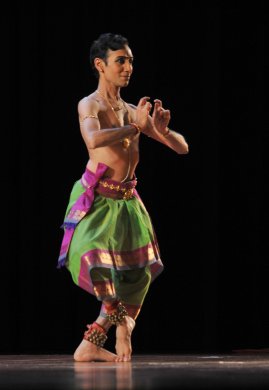 Beginning with the prayer Pranamami Shri Siddhi Vinayaka, Praveen Kumar, a disciple of Narmada teacher of Bangalore and also trained by C.V. Chandrasekhar, took to the stage for evening performance. This was the second time that he performed in the prestigious slot. He was in great form and from the word go to the final Tillana he gave a performance of a very high standard. Praising Lord Panduranga in Pandurangashtakam, he highlighted his divinity; even Parabrahma Lingam worships Panduranga. The diagonal movements on either side projecting the images and the epithets for describing Panduranga's beauty were captivating. He chose Veena Sheshaiyer's varnam Devadideva Nataraja in Shanmukhapriya raga and adi tala. Lord Shiva, the presiding deity of Chidambaram in his primordial from performs in Kanakasabha, the Golden Hall. As a devotee he described the great architectural beauty of the temple, priests and devotees after bath coming to the temple for worship, the vehicle of the lord Nandi in his majesty, the Tandava performed by the lord in the golden hall, all replete with bhava, raga and tala. Using the sollus tam dhi tam Praveen created exquisite visuals. Jatadhara with matted locks, having three eyes Trinetra, while dancing his left leg is raised, the position of Kunchitapada held artistically, he is Girijaramana, the lord of daughter of Himalaya, his locks are adorned by half crescent moon and in one hand he holds a deer, in another damaru, and the devotee also remembers the Ardhanari form; the iconic representation was engaging. Praveen's nritta is full of sparkle, with clean lines and geometric beauty. His teermanams have a punch and easy resolutions. Alternating with abhinaya and nritta, he excels in offering his best. For a male dancer to select a suitable javali for a nayaka from a wealth of javalis was a tough task. But selecting one befitting 'dhrista nayaka' trying his best to please the nayika who spurns all his attempts was an essay in humour and also hasya rasa. Pattabhi Subbarama's javali in Nattakuranji raga and adi tala offered him scope to flatter the nayika addressing her as ambujakshi, lotus eyed, with lips that are superior in colour, coming close to her and suggesting that he would offer her bangles, begs for a kiss but nothing works. Then the gift that he wanted to offer her, he drops on his own head in sheer frustration as the nayika refuses to budge when he tries all his tricks to win her over. Purandardasa's Devaranama is a shared traditional song among the devotees. Praveen's selection to depict Balakrishna form of the lord, who is the lord of three worlds, even the gods wish to have his darshan was depicted with vatsalya bhava, Yashoda churning butter and tempting Krishna to have it, in endearing manner. Asking child Krishna to give her a kiss on her cheek, Yashoda tempts the child who runs away and finally is embraced by the mother. These were the delicate touches Praveen employed with effect. Never did he overact, or make unbecoming gestures. As a tribute to his guru C.V. Chandrasekhar he performed Simhendramadhyam Tillana composed by his guru. The thorough training he has received and imbibed was evident in the execution of his delectable movements. Praveen is of slight build, but is a powerhouse of energy. He won a long standing ovation for his performance. He informed the audience that at the last minute his mridangist Lingaraju had met with an accident and Lalgudi Ganesh stepped in at short notice. Had Praveen not mentioned it, none would have guessed it. It goes to the credit of mridangist Lalgudi Ganesh and Praveen Kumar to rise to the challenge and perform with flawless perfection. Praveen had excellent support of the Bangalore based musicians. Nattuvangam by D.V. Prasanna Kumar, vocal by the vastly gifted D.S. Srivatsa, flute by Mahesh Swamy and violin by Mandya Nagaraj. The team work was commendable. Kijote Kathakali (Don Quixote) 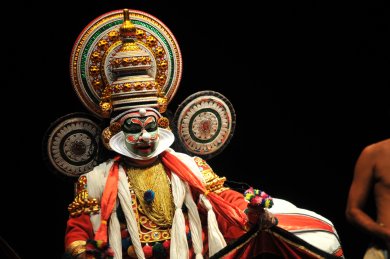 The Indo Spanish Theatre production Kijote Kathakali, based on the attakatha of select scenes from Don Quixote authored by the scholar Dr. P. Venugopalan, was a surprise in store for rasikas. Based on the novel of Miguel de Cervantes and directed by Ignacio Garcia for Case de la India (Spain), it was performed by Margi Kathakali troupe from Trivandrum. The collaboration was supported by The Embassy of Spain in India and Ministry of Culture, Government of India. Kijote Kathakali is an innovative production, fruit of a multiple dialogue between tradition and contemporaneity and between two cultures: Spain and India. The visual richness of this ritual dramatic art and the imaginary world of Don Quixote, both linked in time as their common origin is quite fascinating. The two characters of Alonso Quixano and Quixote Hero are presented in the beginning of the play, which open in the real world in which Quixano, who has read a number of chivalric stories, inhabits this world of airy nothing. He is discovered in this state of madness, for he believes that he is a knight. He dreams that he is Quixote Hero. The dual personality of Quixano as Quixote/Kijote is suggested when Quixano played by Nelliyode Vishnu Vasudevan Namboodri is shown in lungi and bare chest, and in traditional manner in Kathakali, Quixote played by Kalamandalam Sreekumar is introduced behind the curtain in kathi make up. Divided into 11 scenes the play moves smoothly unfolding the story using the traditional Kathakali music and the libretto which is sung melodiously. Don Quixote prepares to set out in search of adventures, battle, chivalry and the attendant glory. The two gifted Kathakali actors play important roles in this play. As Quixote's assistant Squire Sancho Panza, Velayudhan Nair Vijaykumaran is like the Vidushaka in Kutiyattam. The heroine Dulcinea for whom Quixote falls in his imagination is played by Jishnu Ravi. To cure Quixote's madness, Knight of the Mirror is played by K. Balasubramanian (he also doubles as the White Moon).The Rakshasa Demon is played by Kalamandalam Balakrishnan (he doubles as the Lion also). Quixote in kathi make up appears as a great hero in a delirious world of fantasy. After his first journey Quixote feels that he needs the services of a Squire. A simple farmer is recruited as Sancho Panza, whom he promises can rule over the island that he will conquer. They travel together and Quixote encounters Carrasco disguised as a Knight of Mirrors. The famous battle of Quixote with windmills is imaginatively performed by two demon characters that move their arms in circular motion like windmills. Sancho tells Quixote that these are the windmills but he does not listen to him. The scene is full of humour and the Kathakali characters with thadi makeup for demons, as windmills are artistically used. In Quixote's dream world Sancho brings Dulcinea in his presence. She appears in Kathakali attire of a beautiful woman and the shringara padam is rendered; Quixote woos her and she demands that he embrace her. He does so and finds himself embracing only Sancho. The illusion is shattered but he thinks that Dulcinea is there and he loves her. There are few more adventures like two cages tied to a cart and Quixote believes that cart is pulling slaves. He confronts cart driver, who dissuades Quixote not to fight with lion, but he insists. However, the lion is so tired that he comes out and goes back to the cage to sleep. Quixote feels that he has defeated the lion, calling for some celebration with Spanish popular music. The village priest entrusts the task of curing Quixote of his madness to Carrasco who is a new graduate from the university. He appears as the Knight of Mirrors and crosses Quixote's path in the forest. He is shown sleeping on the floor. Quixote challenges him to a duel. The Knight puts condition that whoever loses must follow the order of the winner. But he trips and falls and Quixote wins the duel by fluke. Later on as the Knight of White Moon, Carrasco reappears and defeats Quixote in a battle. He gets wounded and Carrasco sets a condition, if Quixote is defeated he must give up misadventures for one year and return home with Sancho. The penultimate scene and final scene deal with death of Quixano and Quixote in spiritual salvation. Noble Quixano returns to La Mancha. He is beyond the depths of sorrow and is in state of self realization. He appears in his bed accompanied by all his family members and friends: Dulcinea, Sancho and Carrasco. Quixano thinks about his life, about how many books of adventures he had read, and how none of them illuminated the soul. He beholds in front the truth of the cosmic book which streams its glow of spirit divine. He bathes in this and achieves moksha. In his self realization he himself is salvation. Quixote also enters the scene to end his own life as a hero's life. Both their bodies are subsumed in the resplendent soul. The use of Kutiyattam technique for a fairly long death scene is used with artistic approach. Quixano and Quixote as eternal souls walk in an eternal walk. Nelliyode Vishnu Vasudevan appears as Quixano in ordinary clothes as we see him in the first scene and lies on the bed, Quixote in Kathakali vesham lies on the floor. Their final journey is enacted in a touching manner. It indeed was an experience to watch this most unusual production in traditional Kathakali style, and the actors were excellent. Day seven Sathvikaa Shankar 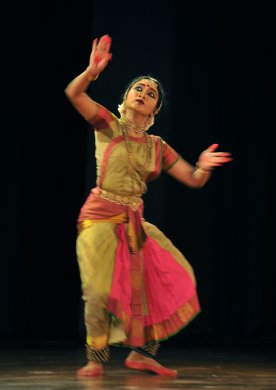 On the final morning, Anitha Guha's young disciple Sathvikaa Shankar once again proved that her guru has an ability to train young dancers in a manner that they imbibe both the aspects of pure dance and abhinaya which highlights the basic structure of Bharatanatyam form. Choreographed by Anitha Guha based upon the text of P.R. Venkatasubramanian, with additional touches of recitation of the text and singing simultaneously, ornamented the Mallari. I have seen traditional Mallari way back in 1958 in All India Dance Seminar performed by a traditional temple dancer which dwelt upon the description of how in a palanquin the lord is taken round the temple. Using the ritualistic aspects with imagination, Anitha has elaborated its presentation. The epithets for Lord Shiva as Nilakanthaya, Mrityunjayaya, with refrain of Hara Hara Shankar, Shiva Shiva Shankara created atmosphere of watching procession in a temple. The poses Sathvikaa took were indicative of the narrative like Shiva has turned Kamadeva into ashes opening his third eye. The sound of damaru with mnemonics like ta dhingin tom tam etc created sound texture. Sathivkaa executed utplavanas effortlessly. Anandabhairavi varnam Sakhiye indha velayil describing nayika's desire to be one with the lord was replete with shringara using simile of a bee hovering over a lotus - nayika's desire to be kissed and embraced by the lord. The overwhelming shyness by mere thinking of being in union with the lord was suggested subtly. It was in Kasturi Ranga's padam Indhendu in Surati that Sathvikaa evoked abhinaya of a woman hurt at her beloved's dalliance with another woman and returning home, trying to make up, and she in turn sarcastically questions him on how come on such a full moon night, he has mistakenly come to her house instead of the house of that other woman, whose eyes are of a shape of fish, Matsyakanni, taunting and removing tears from her eyes. In Nannu brovamani keertanam in Kalyani raga and misra chapu tala, Badrachala Ramdas is imprisoned by the king for raising funds from the revenue collections to build the temple of Rama at Badrachalam. Ramdas appeals to Sita devi, he says: 'O mother sita, a jewel among women, please ask Rama to have mercy on me and free me from the shackles of imprisonment, staying by his side and caressing his cheeks, at the time of your divine union with the lord.' Tillana in Kanada and adi tala composed by Lalgudi G. Jayaraman was joyous becoming the young dancer's mood. Vishal Krishna 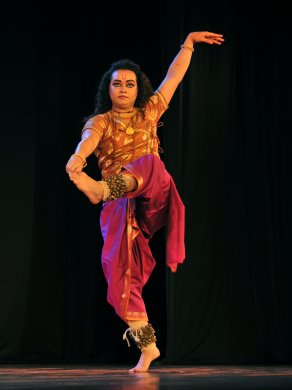 The young star of Banaras gharana Vishal Krishna's energetic Kathak abounded in excellent nritta consisting of paran, tihais, aamad and scintillating footwork with on the spot improvisation upaj ang. With his long jata like hair, he performed with full confidence and pride of his gharana, inherited from Kathak Queen Sitara Devi and his uncle Gopi Krishna, whom he follows faithfully. Vishal Krishna offered to the cognoscenti audience, Kathak fare which was complex and delectable. With an excellent team of musicians - on tabla Vivek Mishra, on pakhavaj Kunal Patil, vocal by Somnath Mishra and on sitar Sandip Niogi - Vishal regaled the audience with his zest and energetic nritta. Beginning with Ardhanari vandana in Bhatiyar and teen taal, to the music by Manoj Desai, he enacted the Ardhanari swaroop of Lord Shiva and Parvati. In describing tandava of Lord Shiva he covered the stage with such speed that the impact of tandava was clearly evoked in contrast to lasya of Parvati, where he covered his face with ghunghat - end of a sari. His aamad with image of peacock, akash bhramari with jumps lifting both the feet, palli tihai with two sides, and one paran created by Sitara titled 'machine gun paran' were full of virtuosity. The delicate nuances in Kathak are displayed in Gat Nikas, the variety of gaits. Showing Krishna holding flute and Radha looking through veil displayed his command over the idiom. His 27 pirouettes were breathtaking. Dancing on the rim of brass plate and executing the talas in perfect sync with tabla player and tintinnabulations of the ankle bells were full of dexterity. To control hundreds of bells and let one bell ring is a result of tireless practice and always entertaining winning rounds of applause from audience. The dance of Krishna with Gopis and pleasing them with dance of peacock that the gopis desired to see, and final Ananda Tandav with mnemonics of dimik dimik damaru kar baje, saw him in his element. The spirit of Sitara and her abundance was seen in his entire body and throughout his performance, as he has studied it from her. Those who were watching him for the first time were mesmerized and gave him a standing ovation. Meenakshi Srinivasan 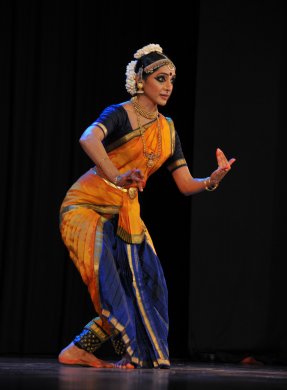 Meenakshi Srinivasan, a disciple of Alarmel Valli, has carved her own individual style with grace. Explaining that she considers dance as an extension of music, she indeed with exquisite music by K.Hariprasad (vocal), V.Vedakrishnaram (mridangam), violin by Eashwar Ramakrishnan and flute by J.B. Sruthi Sagar with nattuvangam by Jayashree Ramanathan, gave an excellent performance. With a svelte figure and complete command over the technique, in her varnam created from lyrics by V.Vijayaraghavan to the music by K. Hariprasad in Ragamalika and adi tala, she unfolded the story of Andal who was confident in her belief that she was to marry only Ranganatha, her lord and none else. Holding the garland to be offered to the lord, she wore it with full joy, knowing well that it was meant for the lord and as a matter of fact must not be worn by her; she reiterates that she loves him and can do so! Meenakshi's abhinaya spoke volumes of her internalizing the meaning of the lyrics and the overall overwhelming love for the lord was shown with deep feeling of devotion. The intense outpourings of Andal found felicitous expression in K. Hariprasad's singing. The references to chakra, conch, the names of the lord - Achyuta, Madhava, Govinda - resounded in the auditorium, the verses on Andal's ornaments, costumes, dancing with the garland, interspersing with nritta as in exposition of a varnam, with teermanams at right place and speed showed Meenakshi's prowess in a pleasant manner. The refrain 'I shall marry you and only you' was joyous. Looking at the portrait of Lord Ranganatha, Andal talks with him, clapping her palms, thinks of him as more beautiful than Kamadeva, Koti Kandarpa; Andal declares that she shall sing, play cymbals, she would not care for any one. She sends her parrot messenger and the arrows of Kamadeva are showered on her. Meenakshi being an architect manages to create architectonic nritta enhancing the beauty of the pure dance form. The jumps are light and create interesting visuals. Choreographing the varnam she has dovetailed several elements imaginatively. The repetition of phrases with tattu mettu, toe heel movements of adavus lead to climax within kalapramanam, a thoroughly enjoyable varanam. In Nadamadi tirinda taught to her by Priyadarsini Govind, she asks Lord Shiva why he has been standing with one foot held above the floor. There are subtle poetic suggestions indirectly alluding to lord's greatness but apparently mockingly asking various reasons. Did he falter knocking on the door of Shakti to whom he was delivering the message? Did he miss the beat when Brahma was playing the tala? Or 'when you went to protect Martanda, your devotee, who clung to you when Yama came to snatch him away from you, did you lose balance and therefore your leg is suspended?' Nindastuti as alankara in literature offers scope to dancers to elaborate and also introduce a sense of humour. Meenakshi pulled it off successfully. In Kuchelopakhyanam of Swati Tirunal's excerpt set to music by K.Hariprasad, Meenakshi portrayed the character of Krishna's childhood friend Sudama's character with gentle hues. The meeting of the two friends was heartwarming. Krishna delighted to receive him washing his feet, making him feel comfortable, enquiring about his family and cleverly snatching the puffed rice Sudama had brought, eating with delight and stopping after few mouthfuls, expressed his pleasure. Sudama and on his return, is amazed to see his wife bejeweled, with several maids looking after her like she was a queen, with his children dressed in royal garbs. Sudama is touched with a deep feeling of gratitude to Krishna. The entire presentation was movingly performed. She concluded her recital with Rajkumar Bharathi's Tillana in Bilhari raga with verses from Tirukkural. Nrityagram 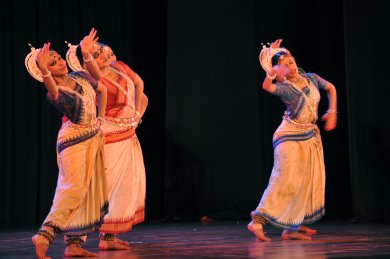 The finale was by the Nrityagram troupe led by Surupa Sen. Unlike last year, this year they presented traditional numbers with a number of young dancers who have been taking training there and practicing round the clock. Mangalacharan with Jagannatha stuti followed by Manikyaveenam uplalayanti prayer ascribed to Kalidasa performed by Surupa set the tone. The melodious music by Bhubaneswar Mishra for some of us evoked nostalgia. Bhumi Pranam with perfect chauka and bhramari, choreographed by Kelucharan Mohapatra is a gem of a number. Resetting Pankaj Charan Das's Sthayi with all the dancers was spectacular with each dancer in chauka position in complete sync, and moving in duets and sometimes in one line, sometimes alternating positions created visual geometry. To the music of Harihar Panda, Pankaj Charan Das's Shankarabaranam Pallavi performed by the group was an essay in choreography by the Adi Guru. It was also announced as Shankarabaranam Mahari Pallavi. As Pankaj Charan Das belonged to Mahari family, his choreography of pallavi was thus re-named. The sculpturesque poses struck by the dancers like looking in mirror - Darpani, holding lamp, in languorous postures brought to life those dancers carved on the walls of the temples. Surupa's resetting of the original choreography added to the charm of the pallavi. Ke kise kohila, a traditional song similar to padams of Kshetrayya, was poignantly rendered by Surupa. 'Who has told you lies, something against me O my Lord? There were times when you looked me without blinking an eye, lest you missed seeing my beauty. You used to embrace me, our love play, all that has vanished; just because someone poisoned your ears you have turned away from me, the unfortunate one.' Surupa with her sensitive visage registered the agony of the nayika. Her entire body spoke of the anguish and state of helplessness. Raghunath Panigrahi's soulful music brought out the pain reflecting the emotions the nayika goes through. Kelubabu's choreography of Muslim poet Salabeg's request to Lord Jagannatha for a glimpse of his darshan is another gem of a number where a Muslim devotee begs Lord Jagannatha to have mercy on him. One who rescued King Gajaraja from the crocodile, saved Draupadi from humiliation when in full view of her five husbands and elders in court Dushashana attempted to disrobe her, killed demon Hiranyakashipu when he wanted to punish his son Prahalada for worshipping Lord Vishnu, the lord taking incarnation of half lion and half man killed him. Salabeg calling himself as a yavan, of low caste, beseeches the lord to remove all sins from his heart and bless him. Pavithra Reddy, another senior dancer, performed it with devotion. One was reminded of similar poem of devotee Nandanar who because he was of a lower caste was not allowed to have darshan of Lord Shiva. Such compositions strike familiar chords in hearts of the viewers. The finale Moksha was performed by two young dancers in Bhairavi raga and ek tali. It was mentioned in the booklet as Kali Tandava Moksha. One wished it was performed by the entire group since Surupa has the imagination and skill to choreograph it. Lynne Fernandez lit up the dancers and the stage with her customary designs and hues. Vocal by Jatin Sahu, mardala by Rohan Dahale and flute by Parashuram Das was melodious bringing out the Odissi flavor. Panel Discussions Since last year, the Academy has started panel discussions on 3 mornings convened by Kami Viswanathan. I missed the panel discussion on the first day moderated by Rajika Puri from NYC and the last day. The 2nd day of panel discussion at 8.30am in the Mini Hall was almost full house. It was heartening to see the hall packed to listen to views of dancers Aditi Mangaldas (Kathak), Neena Prasad (Mohiniattam), Sujata Mohapatra (Odissi), Vasanthalakshmi Narasimhachari (Bharatanatyam and Kuchipudi), Chitra Dasarathy (Bharatanatyam), moderated by London based Chitra Sundaram (Bharatanatyam). It was indeed amazing that within short span of one and half hours each dancer spoke eloquently about tradition and innovation in classical dance. Moderator Chitra Sundaram took more than 20 minutes to introduce the session, which left little time for panelists to discuss. What I remember are the words of Chitra Dasarathy who spoke about Kannada story 'Flowering Tree' and her own immersion in literature. The theme triggers innovation for her. The woman turns into tree and following its fragrance, the man falls in love with the tree, which turns into woman, offering unusual experience of rasa to audience. I have seen group dance by Sharmila Biswas. It has left an indelible impression, but more than that the catalyst agent in such cases is literature. When concluding the session, Shanta Dhananjayan spoke of rasotpatti, generation of rasa and also auchitya, propriety. Aditi had given an example of computer with artificial intelligence creating best of the music of Bach, which was superior to original music of Bach. She said the next generation perhaps will have to aim for that. But there too I feel the need for soaking one's self into literature is a must. Since they ran out of time there was no interaction with the audience. The timing of panel discussions needs reconsideration, because as soon as the discussion is over it is almost 10am and the main morning session of performance by young dancers starts and leaves little time for audience to settle down for the next three hours when one leaves for lunch. Few observations One of the finest dance festivals, the dance festival under review is 'a festival of festivals'. Despite the emphasis on Bharatanatyam form, audiences from various parts of the world look forward to attending this festival. I consider it is like what I look forward to attending the Dance Festival at the Kennedy Centre in Washington, or Barbican Centre in London or at Esplanade theatre in Singapore. The Music Academy plans well in advance for rasikas to book their tickets. The program booklet is sold as soon as it is released at the inauguration, and is according to me, a collector's item. And how many young dancers have performed over the years. The previous generation of divas like Padma Subrahmanyam, Sudharani Raghupathy, Lakshmi Vishwanathan, and Chitra Visweswaran has now been replaced by Alarmel Valli, Malavika Sarukkai, Priyadarsini Govind, Rama Vaidyanathan and others. Similarly the young generation dancers who have been appearing in the morning slots get upgraded to prime evening slots. The very fact that male dancers have been also drawing full houses in the evening slots speaks of changes taking place. Dancers like Parshwanath Upadhye and Meera Sreenarayanan have won unqualified appreciation of the audiences and it speaks volumes for the young generation of dancers who are bound to take over from the female dancers who are dominating the evening prime slots. Other dance forms like Odissi, Kuchipudi, Mohiniattam, Kathak and latest Sattriya dances (of Assam) are also presented every year. It is felt that in their case too, other groups need to be also selected. That would require few of the committee members to travel to other festivals, as well as watching dancers of these forms elsewhere. Chennai is a city of music and Bharatanatyam dance form. With passage of time one expects that changes will be reflected in the 'curating' of the festival. One more observation: Some members of the audience drew attention to the fact that there is poor oxygen circulation in the auditorium due to no proper ventilation. Hopefully the management will make a note of it and do the needful.  Dr. Sunil Kothari is a dance historian, scholar, author and critic, Padma Shri awardee and fellow, Sangeet Natak Akademi. Dance Critics' Association, New York, has honoured him with Lifetime Achievement award. Post your comments Please provide your name and email id when you use the Anonymous profile in the blog to post a comment. All appropriate comments posted with name & email id in the blog will also be featured in the site. |